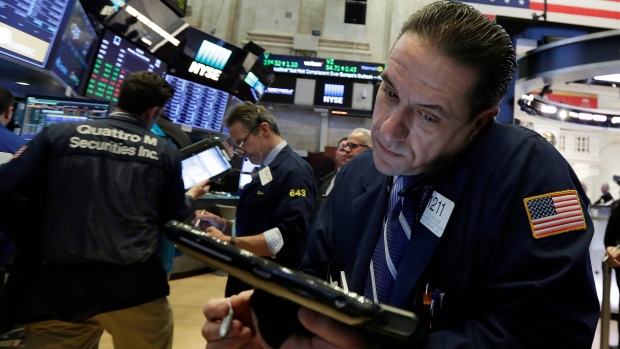Feb 2, 2018
Dow drops more than 650 points in biggest rout since June 2016
, Reuters

Wall Street's main stock indexes suffered their worst week in two years as bond yields soared and renewed fears of inflation gripped investors.
The Dow Jones Industrial Average fell 665.75 points, or 2.54 per cent, to 25,520.96, the S&P 500 lost 59.98 points, or 2.13 per cent, to 2,762 and the Nasdaq Composite dropped 144.92 points, or 1.96 per cent, to 7,240.95.
The S&P/TSX Composite Index closed down 254.89 points, or 1.61 per cent, at 15,606.03, its biggest drop since May. All of the index's 10 main groups were in negative territory.
U.S. MARKETS
But amid the selloff, corporate earnings forecasts keep improving.
Forecasts for earnings, one of the fundamental factors that drives stock prices, are rising fast as analysts factor in benefits from the U.S. tax overhaul.
Optimism over forecasts has caught the attention of anxious investors, who hope that strong earnings can support lofty stock valuations and offset the concerns over rising bond yields and the pace of Federal Reserve rate hikes. Rising interest rates in general mean higher borrowing costs for companies.
This week, fears of higher rates overwhelmed the upbeat profit picture as the benchmark S&P 500 stock index fell 3.9 per cent and raised some concern about a deeper pullback.
"This uptick in bond rates has everybody nervous obviously," said Gary Bradshaw, portfolio manager at Hodges Capital Management in Dallas, Texas.
"But we step back and look, and so far earnings have been awful good. Even though you have seen rates move up some here, they are still very low, inflation is still low," he said.
With half of the S&P 500 index companies still to report fourth-quarter results and potentially give guidance on 2018, profit estimates are likely to increase further.
Even after the selloff this week, the S&P 500 is up 3.3 per cent for this year and that is on top of a 19.4-per cent gain for 2017. Whether this week's downturn in global equity markets continues will depend in part on upcoming earnings reports.
Reports from both Apple and Google parent Alphabet late Thursday disappointed investors, as did Friday's results from ExxonMobil and Chevron, but fourth-quarter S&P 500 company results overall have been much stronger than expected.
Among changes to the tax law, the corporate income tax rate drops to 21 per cent from 35 per cent, so earnings estimates for the first quarter and all of 2018 have jumped.
First-quarter profit growth for S&P 500 companies is now estimated at 17.7 per cent, according to Thomson Reuters data, up from 11.7 per cent on Dec. 20, when both houses of Congress approved the tax revamp. Earnings growth for 2018 is now forecast at 18.2 per cent, up from 11.5 per cent on Dec. 20.
Typically, expectations decline as the earnings reporting season for the quarter approaches. On average, profit growth expectations fall by four percentage points from the start of the quarter to the start of earnings season, said David Aurelio, senior research analyst at Thomson Reuters.
This January, revisions to S&P 500 2018 earnings estimates were 4.3 times more positive than negative, according to Bank of America Merrill Lynch. The one-month ratio of upward to downward revisions was the highest since at least 1986, as far back as the bank's data goes.
All of the S&P 500 companies together are expected to show earnings of about US$155 per share this year in aggregate, up about US$9 since Dec. 20, Thomson Reuters' estimates show.
The tax reform benefit is estimated to add more than that, however, a full US$13, which suggests there "there is more room to run," BofA-ML strategists said in a note.
In addition to the tax law, U.S. companies' earnings are benefiting from improving global economic growth and the weaker U.S. dollar, which helps U.S. multinationals exports sales, said Jill Carey Hall, equity and quant strategist at Bank of America-Merrill Lynch.
Those factors could help to underpin U.S. earnings even after the tax benefit is priced in.
"Stocks may be have been overbought, but some of that was alleviated this week, and global growth and profit growth are still intact," said Bucky Hellwig, senior vice president at BB&T Wealth Management in Birmingham, Alabama.
Among companies due to report next week are Walt Disney , General Motors, several biotech companies including Gilead and restaurants including Chipotle Mexican Grill.
CANADIAN MARKETS
Canada's main stock index slumped to a four-month low on Friday, with natural resource shares leading broad based declines as commodity prices dropped and higher bond yields pressured global equity markets.
The energy group retreated 2.5 per cent. Suncor Energy slipped 1.8 per cent to $43.81, and Canadian Natural Resources Ltd (CNQ.TO) dropped 1.4 per cent to $41.88.
The financials group slipped 1.2 per cent. Bank of Nova Scotia (BNS.TO) gave back 0.9 per cent to $80.01, and Canadian Imperial Bank of Commerce (CM.TO) lost 1.7 per cent to $119.
The materials group, which includes precious and base metals miners and fertilizer companies, lost 2.8 per cent. Barrick Gold Corp (ABX.TO) slipped 3.7 per cent to $17.04, and Goldcorp Inc (G.TO) fell 2.9 per cent to $17.02.
Gold futures fell 1.3 per cent to US$1,331.34 an ounce. [GOL/] Copper prices declined 0.6 per cent to US$7,079 a tonne.








